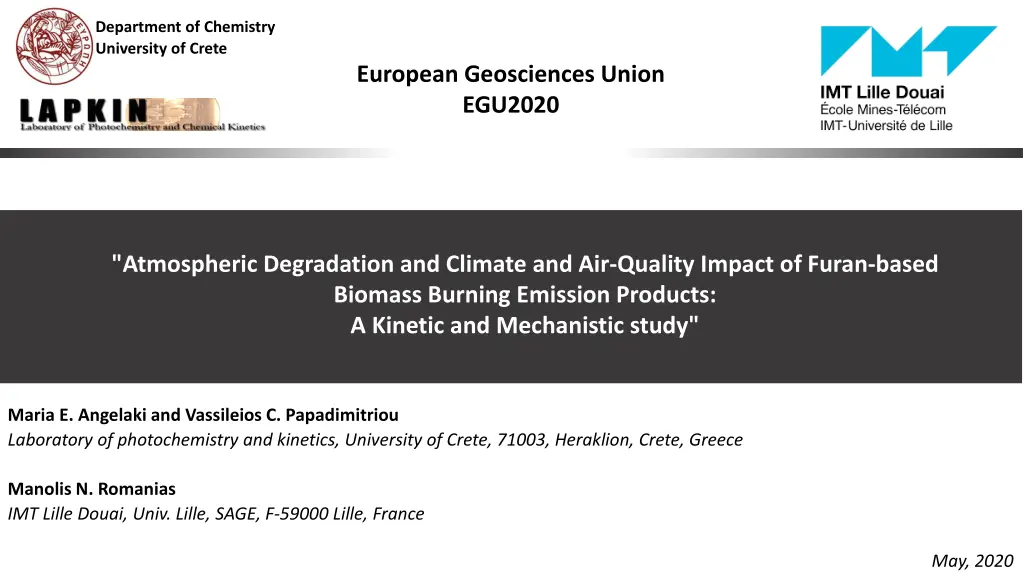
Impact of Furan-Based Biomass Burning Emissions on Atmosphere and Health
Explore the atmospheric degradation and health impacts of furan-based biomass burning emissions through a detailed kinetic and mechanistic study. Learn about the adverse effects on air quality, climate, and human health caused by furan compounds like furfural and maleic anhydride. Discover the experimental techniques and conditions used to study the kinetics of these compounds.
Download Presentation

Please find below an Image/Link to download the presentation.
The content on the website is provided AS IS for your information and personal use only. It may not be sold, licensed, or shared on other websites without obtaining consent from the author. If you encounter any issues during the download, it is possible that the publisher has removed the file from their server.
You are allowed to download the files provided on this website for personal or commercial use, subject to the condition that they are used lawfully. All files are the property of their respective owners.
The content on the website is provided AS IS for your information and personal use only. It may not be sold, licensed, or shared on other websites without obtaining consent from the author.
E N D
Presentation Transcript
Department of Chemistry University of Crete European Geosciences Union EGU2020 "Atmospheric Degradation and Climate and Air-Quality Impact of Furan-based Biomass Burning Emission Products: A Kinetic and Mechanistic study" Maria E. Angelaki and Vassileios C. Papadimitriou Laboratory of photochemistry and kinetics, University of Crete, 71003, Heraklion, Crete, Greece Manolis N. Romanias IMT Lille Douai, Univ. Lille, SAGE, F-59000 Lille, France May, 2020
Biomass Burning Emission Products Biomass Burning (BB) Sources Anthropogenic: Indoor Fires, Agricultural Burning and Fuel Use Biogenic: Wild Land Fires Emission from BB Gases Particles (Primary) Greenhouse Gases High, Semi and Low Volatile Compounds May Lead to Secondary Organic Aerosol Formation Direct Impact on Air-Quality, Climate and Human Health Furan-Based Compounds Recently Identified as Important BB Products High Values of SOAP (Secondary Organic Formation Potential) J. B. Gilman., et. al., Atmos. Chem. Phys., 15, 13915 13938, 2015
Impact of Furan-based Compounds Heterocyclic Oxygenated Organic Compounds (Aromatic or Non-Aromatic) R Semi Volatile ( OH, CnH2n+1, C(O)R R: CnH2n+1 , n 0) High Volatile Low Volatile Furan Furfural V.P. ~2 Torr (296 ) Maleic Anhydride V.P. ~470 Torr (296 ) V.P. ~0.16 Torr (296 ) Adverse Effect of Furan-based Compounds Humans Health: Causing Pulmonary Problems and Cancer (Potent Condensation on Atmospheric Particles) Air Quality: May Lead to Photochemical Production O3 and Secondary Organic Aerosol Formation (SOA) Alter Atmospheric Irradiation and Chemistry Balance
Aim of This Work Evaluation the Hole Impact of Furans to Atmosphere, Air Quality and Health Detail Kinetic and Mechanistic Study of Gas-Phase Oxidation of Furan, 2-MethylFuran, 3-MethylFuran, Furfural, Maleic Anhydride, BenzoFuran, 5-Hydroxy-(2,5H) Furanone with , Cl, NO3, O3: X Kinetic Study Determination of Rate Coefficients, kx(T,P) Over the Temperature and Pressure Range: 273 363 K, 0.002 760 Torr Mechanistic Information about the Potent Degradation Pathways Addition of X on Furan Ring or/and -H Abstraction Pathway Evaluation of their Contribution ? ? ? ? ? ? ????= Determination of Lifetime (Gas Phase Chemistry) ???+ ??? + ???? + ??? + ??????????? Mechanistic Study Key Role Products are Potent Precursors for SOA Formation End Oxidation Products Identification and Yields Quantification Secondary Organic Aerosol Production and Quantification This Presentation focuses on OH Kinetics of Furan and 2-Methylfuran 2-Mathylfuran (C5H6O) Furan (C4H4O)
Experimental Techniques and Conditions OH kinetics a. 600 L Teflon Chamber THermAL Regulated AtMOSpheric Simulation Chamber THALAMOS b. Thermostatic Cage enables Control of Temperature b c. Introduction of Reactants d. Homogeneity of Gas Mixture e e. UVA and UVC Lamps for Production of Reactive Species d f. Detection Techniques Chemical Ionization Mass Spectrometry Infrared Spectroscopy a c f Noureddin Osseiran, Manolis N. Romanias, Vincent Gaudion, Maria E. Angelaki, Vassileios C. Papadimitriou, Alexandre Tomas,Patrice Coddeville, Frederic Thevenet, 2020 Precursors for OH Radicals H2O2Photalised with UV-C Irradiation HONO Photalised with UV-A Irradiation RELATIVE RATE COEFFICIENTS DETERMINATION kF [?????]0 ?????? ?? ???? [???]0 ???? ?? (?????_? ?) = ?? (?????_??? ?) kRef P2 P1 OH + Furan OH + Ref
OH Kinetics with Furan at 296 K and 760 Torr Relative Rate Measurements for OH + C4H4O, k(296 K, 760 Torr) FT IR SIFT MS k(296 K, 760 Torr) = (4.15 0.24) 10-11cm3molecule-1s-1 k(296 K, 760 Torr) = (4.04 0.20) 10-11cm3molecule-1s-1 Agreement Between Reference Reactions and Detection Techniques ~ 3 %
Temperature Dependent OH Kinetics with Furan Comparison with 2-Methylfuran Arrhenius Plot for OH + C4H4O, k(T, 760 Torr) Relative Rate Measurements for OH + C4H4O, k(T, 760 Torr) Negative Activation Energy Complex Reaction Mechanism Decrease of k1as Temperature Increases Formation of an intermediate adduct during OH addition to the double bond that its stabilization is favored at low temperatures where the thermal energy of the system is low
Comparison of Furan with 2-Methylfuran Arrhenius Plot for OH + C4H4O, k(T, 760 Torr) Arrhenius Plot for OH + C5H6O, k(T, 760 Torr) Both Negative Activation Energy Complex Reaction Mechanism kOH(296 K) k1< k2 (4.04 0.32) 10-11cm3molecule-1s-1 k1 -CH3 Increase the Electronic Density of Furan Ring -H Abstraction from CH3Group is Competing Preserving the Aromaticity Substitutes Play Key Role in Reactivity (7.77 0.52) 10-11cm3molecule-1s-1 k2
Atmospheric Implications of Furan and 2-Methylfuran Fast Removal from the Atmosphere Fast Reactions Short Lifetimes Furan 2-Methylfuran [OH]avg= 106molecule cm-3 = 3.6 hours = 6.9 hours Furan and 2-Methylfuran are two High Volatile Compounds -H Abstraction Other Processes Addition of OH to the Double Bond Degradation with OH Radicals through Complex Reaction Mechanism Unsaturated and Big Molar Mass End Oxidation Products 1Maleic Anhydride: Product from 2-Methylfuran + OH Lower Volatility Leading to SOA Formation Production of Other Furans 1A. Bierbach, et al., Atmospheric Environment, 29, 2651-2660, 1995
Maleic Anhydride A Very Low Volatile Organic Compound Atmospheric Degradation Reaction with OH Photalised at Actinic Wavelengths C2H2(CO)2O, Furan-2,5-dione k(296 K, 760 Torr) = (4.09 0.04) 10-13cm3molecule-1s-1 (This Study) Maleic Anhydride Slow Process Vapor Pressure (296 K) = 0.16 Torr Even Lower at Low Temperatures Higher Altitudes Primary Aerosol Formation due to Potent Condensation on Atmospheric Aerosols Products may have Lower Volatility Secondary Organic Aerosol Formation
Conclusions Furans are important biomass burning products mainly from fires and fuel use They have an adverse effect on Air-Quality, Climate and Human Health Removal Processes: Photolysis and Reaction with OH, Cl, NO3and O3 Fast Removal from Troposphere, Short Atmospheric Lifetimes However End-Oxidation Products may Play a Key-Role to Air-Quality Potent Precursors for Secondary Organic Aerosol Formation Alter Atmospheric Irradiation and Chemistry Balance Related to Health Issues Future work Kinetic Study with NO3and O3 Identification and Quantification of All Gas Phase End-Oxidation Products and SOA Evaluation the Hole Impact of Furans to Atmosphere, Air Quality and Health
Acknowledgments cole Mines-T l com IMT Universit de Lille University of Crete, Department of Chemistry Scientific Supervisor: Dr. Vassileios C. Papadimitriou Scientific Advisor: Pr. Maria Kanakidou Members of Committee Prof. Maria Kanakidou Prof. Demetrios Anglos Ass. Prof. Constantinos Milios Ass. Prof. Manolis ROMANIAS Prof. Alexandre TOMAS Prof. Frederic THEVENET Group This research is co-financed by Greece and the European Union (European Social Fund- ESF) through the Operational Programme Human Resources Development, Education and Lifelong Learning in the context of the project Strengthening Human Resources Research Potential via Doctorate Research (MIS-5000432), implemented by the State Scholarships Foundation ( )






















